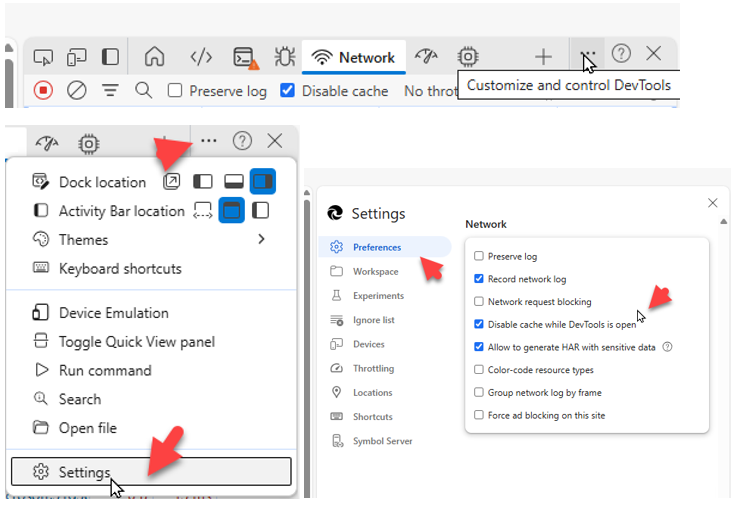Generate network logs (HAR files)
When you contact Gliffy support (see Contact support), we may request that you send us an HTTP ARchive (HAR) file. These files are network logs that track your web browser's interaction with a website. These files help us troubleshoot and identify the root cause of issues with Gliffy.
We may also request web browser console logs. For more information about those, see Generate console logs.
Click your web browser below and follow the steps to generate this file and then send it to us.
-
In your web browser, open the Gliffy diagram that is causing the issue.
-
On your keyboard, press F12 to open your web browser console's.
-
In Chrome Menu in the top right corner, select Tools - Developer Tools.
-
At the top of the pane that opens, click the Network tab and click the settings icon in the top right corner.
-
In Settings, click Preferences. Alternatively, press the F1 key.
-
In the Network section, select the checkbox:
-
Check the box for Disable cache while DevTools is open.
-
Check the box for Allow to generate HAR with sensitive data.
Check Allow to generate HAR with sensitive data to get a HAR file that is not sanitized. Chrome will include the content of HTTP responses in the file. This information is needed to determine the source of an issue. -

-
-
On your keyboard, press F5 to refresh the page and to start capturing network traffic for the web page.
-
In Gliffy, perform the steps that trigger the issue or performance problem.
-
In the Network tab, click the Export icon and select Export HAR (with sensitive data).

The information from the Network tab is saved as HAR.
-
Attach the HAR file in your Gliffy support ticket.
-
In your web browser, open the Gliffy diagram that is causing the issue.
-
On your keyboard, press F12 to open your web browser's console.
-
At the top of the pane that opens, click the Network tab.
-
On your keyboard, press F5 to refresh the page and to start capturing network traffic for the web page.
-
In Gliffy, perform the steps that trigger the issue or performance problem.
-
In the console pane, right-click where the rows of network traffic are shown and choose Save all as HAR.
-
Before sending the HAR file to Gliffy, remove or censor any sensitive information (such as passwords or other confidential information) using a plain text editor.
-
Attach the HAR file in your Gliffy support ticket.
-
In your web browser, open the Gliffy diagram that is causing the issue.
-
On your keyboard, press F12 to open your web browser's console.
-
Click the Network tab.
-
Click the three-dot-menu (Customize and control DevTools) - Settings - Preferences. Alternatively, press the F1 key.

-
On your keyboard, press F5 to refresh the page and to start capturing network traffic for the web page.
-
In Gliffy, perform the steps that trigger the issue or performance problem.
-
In the Network tab, click the Export icon and select Export HAR (with sensitive data).

-
Attach the HAR file in your Gliffy support ticket.
-
In your web browser, open the Gliffy diagram that is causing the issue.
-
From the Safari menu, click Develop > Show Web Inspector.
If you don't see the Develop menu, choose Safari > Preferences > Advanced, and then, select Show Show Develop menu in menubar to add it to your Safari Menu Bar. -
In the Web Inspector, click the Network tab.
-
On your keyboard, press Command+R to refresh the page and to start capturing network traffic for the web page.
-
In Gliffy, perform the steps that trigger the issue or performance problem.
-
In the console pane, Ctrl-click where the rows of network traffic are shown and choose Export as HAR File.
-
Before sending the HAR file to Gliffy, remove or censor any sensitive information (such as passwords or other confidential information) using a plain text editor.
-
Attach the HAR file in your Gliffy support ticket.
-
In your web browser, open the Gliffy diagram that is causing the issue.
-
On your keyboard, press Ctrl+Shift+i to open your web browser's console.
-
At the top of the pane that opens, click the Network tab.
-
Select the Disable cache check box to prevent further caching of the web page.
-
On your keyboard, press F5 to refresh the page and to start capturing network traffic for the web page.
-
In Gliffy, perform the steps that trigger the issue or performance problem.
-
In the console pane, right-click where the rows of network traffic are shown and choose Save all as HAR with content.
-
Before sending the HAR file to Gliffy, remove or censor any sensitive information (such as passwords or other confidential information) using a plain text editor.
-
Attach the HAR file in your Gliffy support ticket.